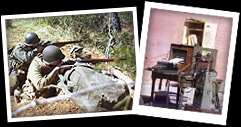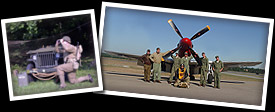Conference Course
Training Bulletin
NO. GT-20
March 15, 1943
The Rifle Platoon and Squad in Offensive Combat
The Infantry School, Fort Benning, Ga
Original thanks to Mike Fox of the 30th Division Reenacting Organization
Part One
The Approach March
Part One
Section I. ORGANIZATION OF THE RIFLE PLATOON
Section II. THE RIFLE PLATOON AND SQUAD IN THE APPROACH MARCH
The primary purpose of this bulletin is to present by schematic diagrams and sketches, some of the principles and methods of employment of the rifle platoon and squad in offensive combat.
Section I.
ORGANIZATION OF THE RIFLE PLATOON
THE RIFLE PLATOON - The platoon consists of a command group and three rifle squads.
THE COMMAND GROUP - The command group consists of the platoon leader, platoon sergeant (second-in-command), platoon guide, and two messengers. (See FM 7-10, par. 100.) Communication with company headquarters is usually by messenger. (See FM 7-10, par. 102)

THE RIFLE SQUAD - The rifle squad consists of a squad leader, two scouts (riflemen), an automatic rifle team (automatic rifleman, assistant automatic rifleman, and ammunition bearer), five riflemen (one of whom is the alternate antitank grenadier), and the assistant squad leader (antitank grenadier). (See FM 7-10, par. 133.) Each soldier is trained to fire all the weapons of the squad.
DUTIES AND POSITIONS OF LEADERS
THE PLATOON LEADER - The platoon leader is the first fighting man of the platoon. He is responsible for the training, discipline, control, and tactical employment of the platoon. (See FM 7-10, par. 101a.)
"The platoon leaders who cannot command, who cannot forsee things, and who cannot act on the spur of the moment in an emergency are a distinct detriment." ...Combatant on Guadalcanal.
THE PLATOON SERGEANT - The platoon sergeant is second-in-command. He assists the platoon leader in controlling the direction and rate of movement of the advance. During all operations he takes post as directed by the platoon leader so as best to assist in the control of the platoon. He replaces the platoon leader when the latter is not with the platoon or becomes a casualty. (See FM 7-10, par. 101b.)
THE PLATOON GUIDE - The platoon guide (a sergeant) prevents straggling and enforces orders concerning cover, concealment, and discipline. His position is usually in rear of the platoon, where he observes the situation on the flanks and the rear. He checks ammunition expenditure and replenishes ammunition at every opportunity. (See FM 7-10, par. 101c.)
"Our junior leaders are finding out that they must know more about their men. The good leaders do." ...Combatant on Guadalcanal.
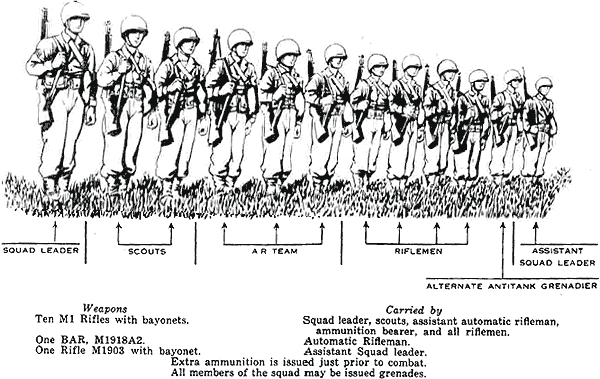
THE SQUAD LEADER - The squad leader is responsible for the discipline, appearance, training, control, and conduct of his squad. He leads it in combat. The squad leader must train his squad to use and care for its weapons, to move and fight efficiently as individuals, and function effectively as a part of the military team. (See FM 7-10, par. 134a.)
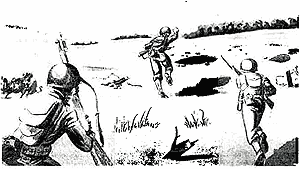
THE ASSISTANT SQUAD LEADER - The assistant squad leader performs duties assigned by the squad leader and takes command of the squad in his absence. (See FM 7-10, par. 134b.) He is armed with the M1903 rifle and antitank grenade launcher: he employs high-explosive antitank rifle grenades to combat any hostile armored vehicles that come within range-- approximately 75 yards. (For characteristics of antitank grenades and sighting and aiming, see FM 23-30 and changes thereto.)
Section II.
THE RIFLE PLATOON AND SQUAD IN THE APPROACH MARCH
GENERAL - The purposes of the approach march are to bring the regiment close to the enemy with minimum losses and to increase it's readiness for action. (FM 7-40, par. 157b.)
For the battalion, the approach march begins when it changes from route march formation to one made up of several smaller columns and ends when its attaching echelon crosses the line of departure. (FM 7-20, par. 109a.)
Unless covering forces to the front are sufficiently strong to protect the regiment against ground attack except by hostile patrols or armored units, the regimental intelligence and reconnaissance platoon usually operates, under regimental control, from 3 to 5 miles ahead of the foot elements of the leading echelon of the regiment. (FM 7-20, par 114b.)
In addition to the security provided by advance motorized elements, the leading echelon provides for frontal security of the battalion. It covers its advance with scouts or patrols. (FM 7-20, par. 115a.)
The approach march is conducted to bring the company close to the enemy in readiness for action and with minimum losses. It begins when the company leaves the route column to deploy as ordered by the battalion commander; or in the event of sudden emergency it begins when the company commander deploys on his own initiative to avoid undue losses. It ends when the company reaches a point from which it must engage in a fire fight to advance farther without excessive casualties. (See FM 7-10, par. 11a.)
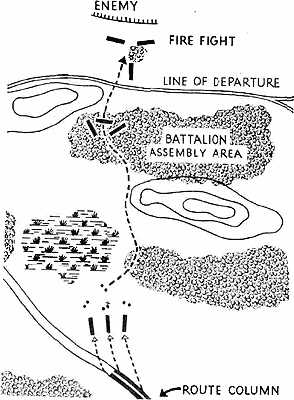
RIFLE PLATOON IN APPROACH MARCH
The above diagram is schematic and illustrates the leading platoon of a rifle company from the time it leaves the route column until the fire fight commences.
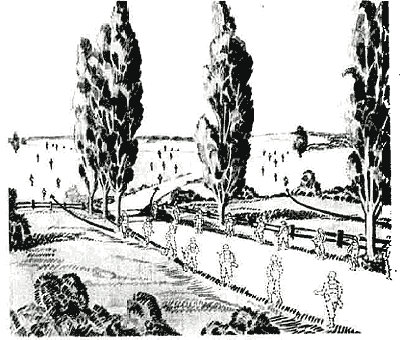
PLATOON DISPOSITIONS DURING THE APPROACH MARCH
The initial disposition of the platoon when it leaves the route column, as part of the leading echelon of the battalion, may be prescribed by the company commander, although this is usually done by the platoon leader. Thereafter, the platoon leader considers the terrain and the situation, changing the formation as needed to advance his unit (within the company formation) with minimum losses and in readiness for combat. (See FM 7-10, par. 106.)
The platoon dispositions most frequently used during the approach march are: platoon column; line of squads; two squads forward, one squad back; and one squad forward, two squads back. Squads may also be echeloned to the right or left rear. (See FM 7-10, par. 106a.)
When the platoon leaves the route column, one messenger reports to the company commander and one remains with the platoon leader. (See FM 7-10, par. 101d.)
The platoon sergeant's position is not fixed. At all times he takes post as directed by the platoon leader so as best to assist in the control of the platoon. (See FM 7-10, par. 101b.)
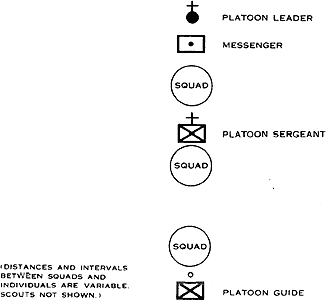
PLATOON COLUMN
This formation is easily controlled and maneuvered. The depth of a platoon column averages 150-200 yards. (See FM 7-10, par. 106a(2).)
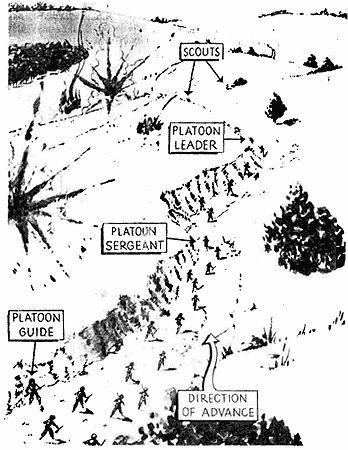
"Platoon column" is especially suitable for narrow, covered routes of advance and for maneuvering through gaps between areas receiving hostile artillery fire. (See FM 7-10, par. 106a(2).)
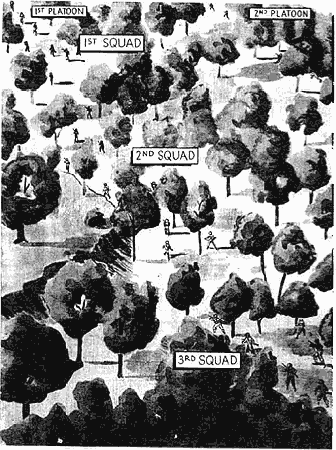
"Platoon column" is suitable for moving a platoon through woods and in fog, smoke, or darkness. The distances and intervals between squads and individuals are reduced so as to maintain visual contact. The rate of advance depends upon the degree of visibility. (See FM 7-10, par. 106a(2).)

"Platoon column" is particularly vulnerable to fire from the front. A change in disposition must be made in order to employ the weapons to the front. (See FM 7-10, par. 106a(2).)
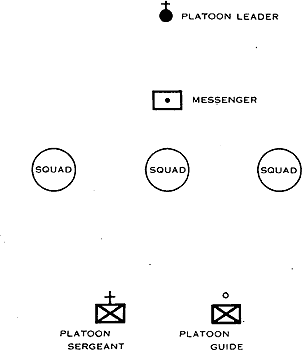
LINE OF SQUADS
This formation is more difficult to control than, and lacks the maneuverability of, platoon column. However, it is less vulnerable to fire from the front. (See FM 7-10, par. 106a(3).)
The platoon deploys with sufficient intervals between squads to permit minor maneuvers of squads. Unless otherwise directed, squad columns or squads disposed in the diamond formation keep about 50 yards apart. (FM 22-5, par. 271, as changed.)
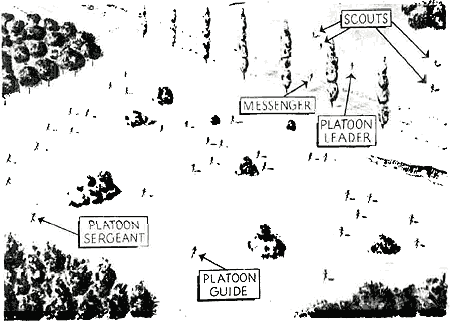
"Line of squads" is suitable for crossing an area exposed to hostile long-range machine-gun or artillery fire which cannot be avoided. It enables the platoon leader quickly to develop maximum fire power to the front.
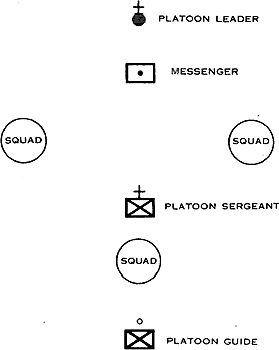
TWO SQUADS FORWARD, ONE SQUAD BACK
This formation provides security to the front and flanks and favors maneuver and control. It provides flexibility to meet new tactical situations. (See FM 7-10, par. 106a(4)(a).)

The disposition with two squads forward is to be preferred to a similar formation with one squad forward when the platoon is assigned a wide frontage. It also provides a large volume of fire initially should a hostile force be encountered to the front. (See FM 7-10, pars. 106a(4)(a) and 106f.)

ONE SQUAD FORWARD, TWO SQUADS BACK
This formation provides security to both front and flanks, and favors maneuver and control. It provides flexibility to meet new tactical situations. (See FM 7-10, par 106a (4) (a).)

Whether this platoon formation with one squad forward and two squads back (or the similar one with two squads forward) is employed, depends upon the terrain, the frontage, and the proximity and actions of the enemy. This formation is the more suitable when the direction from the enemy fire may come is not known. (See FM 7-10, par. 106a(4)(a).)
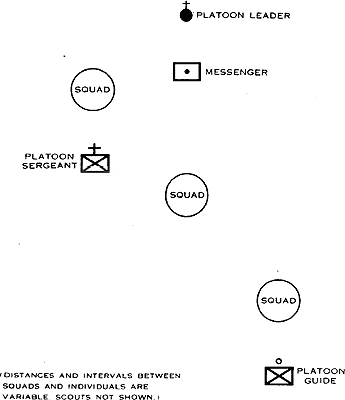
A formation with the squads echeloned to the right or left rear is a variation of the formation with one squad forward and two squads back.

A formation such as that shown above is used to protect an exposed flank. It permits maximum fore to be delivered promptly toward that flank. (See FM 7-10, par. 106a(4)(b).)
SQUAD DISPOSITIONS - When the platoon leaves the route column to take up the approach march, the initial (first) formation may be prescribed by the platoon leader; thereafter, the squad leaders change the disposition of their squads to meet changes in the situation and terrain.
The squad dispositions (formations) are: squad column, as skirmishers, and the diamond formation. (See FM 7-10, par. 142 (a) as changed by Changes No. 1.)
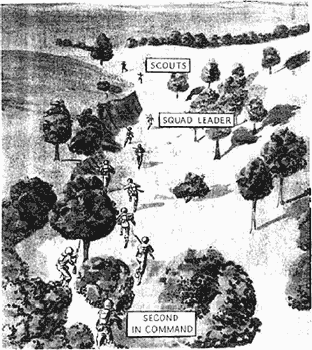
SQUAD COLUMN
"Squad column" can be easily controlled and maneuvered. This formation is used for crossing irregular terrain, in narrow covered routes, or for crossing areas exposed to artillery fire. Squad column facilitates immediate action toward the flanks. The disposition of individuals in the column must be adapted to the terrain and enemy action, and may vary from a widely spaced and staggered column suitable for crossing very open country to a column of files closed up behind the leader. (See FM 22-5, par. 258)
Like the platoon column, this formation is suitable for movement in fog, smoke, darkness, or in woods, provided the distances between squad members are lessened to maintain contact and control. (See FM 7-10, par. 142a(1).)
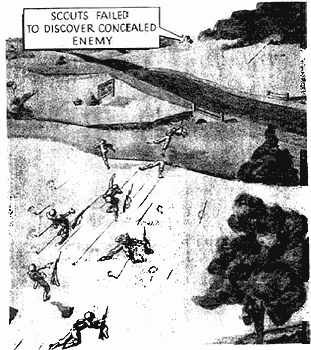
"Squad column" should not be used in open terrain, as it offers an ideal target to automatic weapons with their narrow but deep cone of fire. This formation does not permit the quick use of all squad weapons to the front.

AS SKIRMISHERS
"As skirmishers" is used in the approach march for advancing over open terrain that cannot be avoided, in rapid dashes across open spaces, and for crossing areas being shelled. This formation is more difficult to control than the diamond formation or the squad column.
"As skirmishers" is the fighting formation of the squad and permits the immediate use of all weapons to the front. (See FM 7-10, par. 142a(2).) The interval between skirmishers is approximately 5 paces.

ATTACHED WEAPONS
In the approach march, a 60-mm mortar squad frequently is attached to a leading platoon. This not only provides additional fire power, but enables the platoon leader immediately to engage defiladed targets, or small areas believed to contain the enemy. (See FM 7-10, par. 12d(3).)
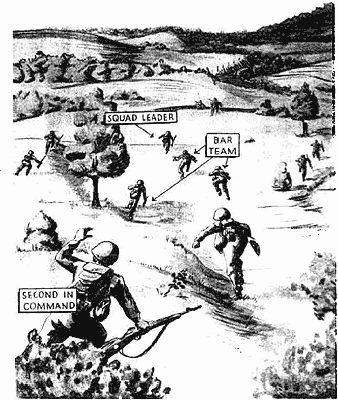
DIAMOND FORMATION
This is a suitable formation to use when fire is likely to be encountered but its direction cannot be predetermined. It provides maximum all-around protection while advancing. This formation is easily controlled and maneuvered. (See FM 7-10, par. 142 a (3) as changed by Changes NO. 1.)
The diamond formation is not so easy to control as is the squad column, since the squad leader frequently must use arm-and-hand signals. Normally, the width of the formation will be from 20 to 30 paces, and the distance from front to rear about 40 paces. However, visual contact must be maintained by the squad members with the leader at all times.
DIRECTION AND RATE OF ADVANCE, BASE PLATOON - The company commander usually designates a base platoon fro the approach march. The platoon leader of this platoon is responsible for the direction assigned and the rate of advance. (See FM 7-10, par. 106b(1).)
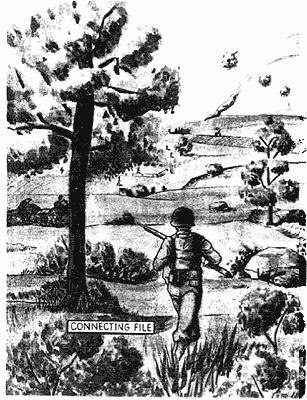
CONTACT MUST BE MAINTAINED
When a platoon follows another unit, contact is kept by means of connecting files when poor visibility or the intervening terrain makes visual contact difficult. At times, double connecting files may be necessary to maintain unbroken contact. (See FM 7-10, par. 106c.)

BASE SQUAD
Each platoon leader designates a base squad. The other squads guide on the base squad. Intervals and distances between the squads depend upon the terrain, enemy observation, and enemy fire. (See FM 7-10, par. 106b(2).)
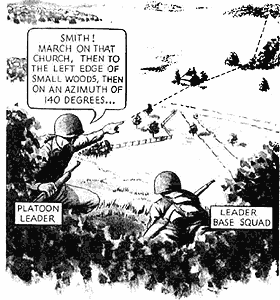
DIRECTION OF FIRE
The platoon leader indicates to the leader of the base squad the direction of advance by pointing out a route or terrain features, moving in the desired direction, stating a magnetic azimuth, or by a combination of these methods. (See FM 7-10, par 106b (2).)
MARCH OBJECTIVE - In the daylight approach march, the platoon is assigned an initial march objective by the company commander. (See FM 7-10, par. 106d.)
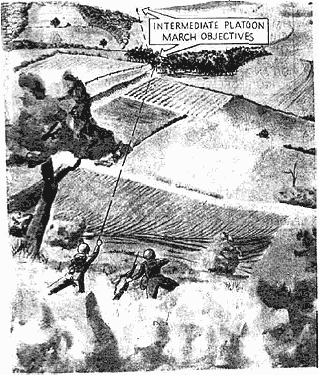
MOVEMENT BY BOUNDS TO INTERMEDIATE MARCH OBJECTIVES
When the initial march objective cannot be pointed out, the platoon leader indicates to the base squad leader, intermediate terrain features on which to march. These features are called intermediate platoon march objectives. The approach march then becomes a series of bounds to these objectives. (See FM 7-10, par. 106d.)

USE OF COVER AND CONCEALMENT
During the approach march, the platoon must take every advantage of cover and concealment provided along its assigned route by folds in the ground, brush, ravines, reverse slopes, woods and similar terrain features. (See FM 7-10, par. 106b (2).)
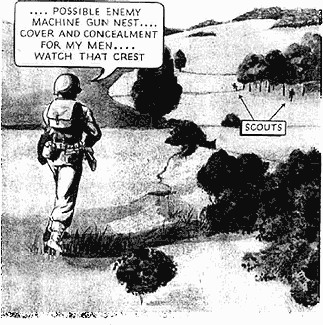
CONSIDERATION OF TERRAIN FEATURES
The platoon and squad leaders precede their units and carefully consider each terrain feature for the cover and concealment it might offer their units, as well as for hiding places it might afford the enemy.

DEVIATION FROM ROUTE
The platoon leader makes minor deviations in the advance of the platoon to avoid obstacles, dangerous areas, and prominent terrain features likely to be shelled. (See FM 7-10, par. 106b (2).)
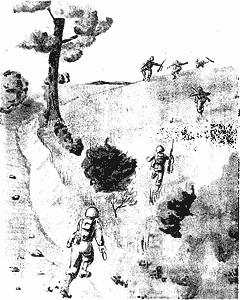
EXPOSED AREAS MUST BE AVOIDED IF POSSIBLE
Units or individuals crossing ridges, crests, and small open areas make good targets for the enemy. The men shown should have used the excellent cover available.
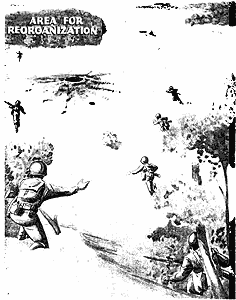
EXPOSED AREAS THAT CANNOT BE AVOIDED
Crests, ridges, and open areas which are exposed to hostile observation or fire and cannot be avoided, must be crossed rapidly by rushes of individuals or small groups. The squads reform in a designated location. (See FM 7-10, par. 106d.)
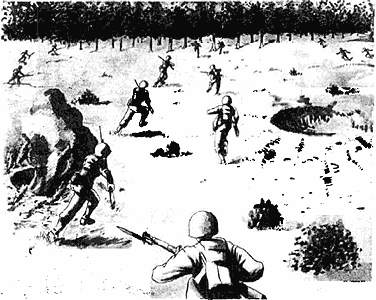
EXPOSED AREAS RECEIVING ARTILLERY FIRE
Areas being shelled that cannot be avoided can frequently be crossed by rushes, during lulls in the firing. (See FM 7-10, par. 106d.)

STANDARD WARNING SIGNAL
To transmit warning of the approach or presence of hostile aircraft or armored vehicles, the following signals are used: three long blasts of a whistle repeated several times, three equally spaced shots, or three short bursts from an automatic weapon. (See FM 7-10, par. 9c (2).)
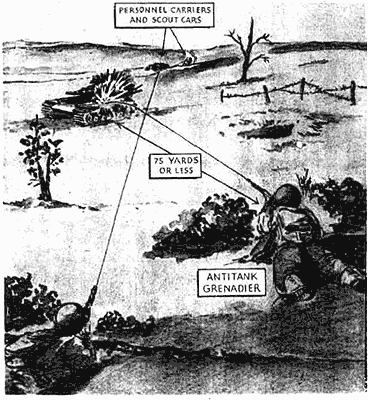
ANTIMECHANIZED FIRE
Should hostile armored cars (reconnaissance vehicles) be encountered or in case of attack by light or medium tanks, antitank rifle grenades are employed within effective range (75 yards). Riflemen fire upon personnel carriers and armored cars. (See FM 7-10, pars 2b(5), 9c(3).)

HOSTILE AIRCRAFT
When concealment is essential and is believed to have been achieved, hostile airplanes should not be fired upon. (See FM 7-10, par 9c(3)(b).)
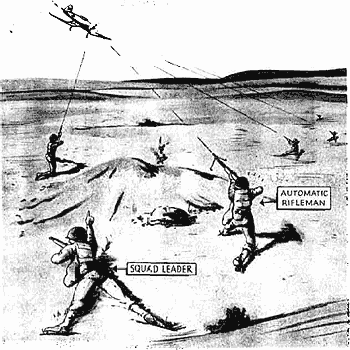
ANTIAIRCRAFT FIRE
When concealment is not essential or does not exist, all weapons will open fire upon enemy aircraft flying within effective range. Automatic rifles provide an easily controlled yet large volume of fire against low-flying aircraft. (See FM 7-10, par. 9c(3)(b).)
The following is extracted from Training Memorandum No. 4, Allied Force Headquarters, North Africa, dated December 28, 1942.
"12. The armament of enemy attack aircraft appears in some cases to be so adjusted that a small cannon fires on a motor column while machine guns sweep the ditches on both sides of the road. If men leave vehicles to escape strafing they should disperse into the fields at least 60 yards beyond the ditches. The aircraft usually bomb first, then return for fire attack. In many cases opportunities for effective fire at hostile aircraft within easy range of small arms have not been exploited. The cumulative fire power of a number of rifles, together with that of every other available weapon, will contribute effectively to the protection of either foot or motor columns against low-flying aircraft. Experience has shown that when enemy aircraft meet such a volume of fire from ground troops, they cease attacking at low altitudes. The duty of every individual soldier to contribute his share of fire, small as it may seem to him, is obvious."
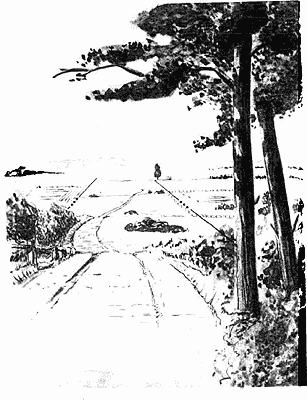
ZONE OF RECONNAISSANCE
In a daylight approach march, the commander of a leading company assigns his leading platoons zones of reconnaissance. These zones may be 300 or more yards in width. Each leading platoon advances generally within its own zone. (See FM 7-10, par. 106f.)
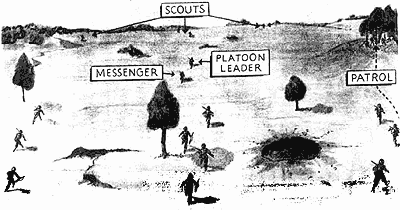
PLATOON SCOUTS, PATROLS
A leading platoon covers its zone of reconnaissance with scouts or patrols, or both, under the control of the platoon leader. (See FM 7-10, par. 106f.) They act as a screen to investigate possible danger areas, seek out the enemy, and prevent surprise hostile fire. The distance the scouts precede the platoon is governed by orders of the platoon leader and varies with the ground and with the probable position of the enemy. (See FM 7-10, pars. 106f and 142d(1).)
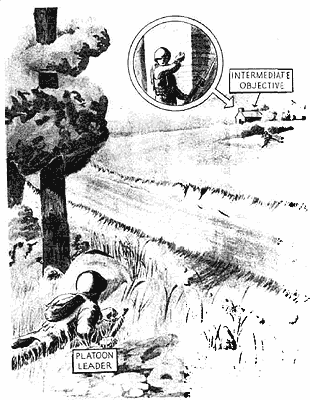
ADVANCE OF THE PLATOON
The platoon leader regulates the movement of the scouts and patrols to insure security by one of three methods:
a. The platoon may remain under cover while the scouts reconnoiter the march or intermediate objective. When the scouts signal "forward," the platoon leader advances to them with the platoon. He then sends the scouts forward to the next objective. While it affords security, this is the slowest and ordinarily the least desirable method of advance.

b. The platoon leader may follow the scouts to an intermediate objective, and if this is clear, send them forward to the next objective. He then signals for the platoon to leave its last position of cover and advance tot he intermediate objective. This method insures security of the platoon by having it under cover until the next objective has been reconnoitered.
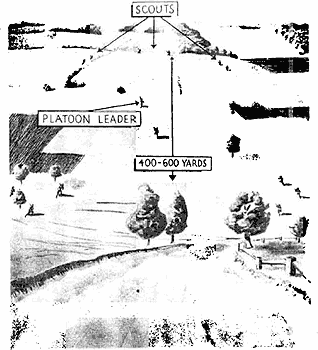
c. The platoon leader may direct the scouts to precede the platoon at midrange (400-600 yards) while he follows them. This method permits the platoon to advance rapidly without being exposed to small-arms fire within it's midrange. It is appropriate for an advance over terrain lacking suitable march objectives, such as level, open country.
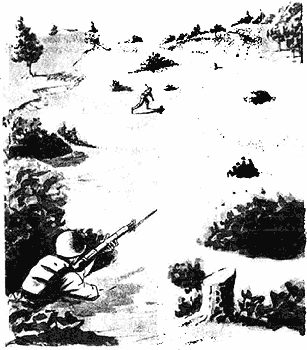
ADVANCE OF THE SCOUTS
The scouts move out boldly to reconnoiter terrain features that might hide the enemy and seek to force enemy riflemen and machine gunners to disclose their positions. They cross limited exposed areas at a run, avoid the skyline and contrasting backgrounds, and take advantage of cover and concealment without delaying their progress.
The pair of scouts from each squad acts as a team; one covers the advance of the other. The rear scout watches for the platoon leader's signals. (See FM 7-10, par. 142d(1).)

POSSIBLE ENEMY LOCATIONS
On approaching possible enemy locations or dangerous points, one scout reconnoiters the locality while covered by the other scout. The reconnaissance must be quick but thorough. (See FM 7-10, par. 142d(2).)
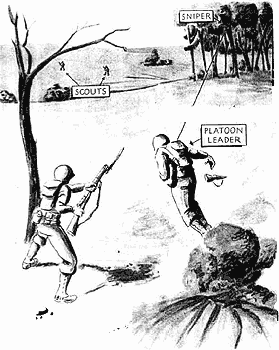
SNIPERS
Scouts and patrols must be on the alert for the lurking enemy. Trees, like other terrain features, may conceal snipers.
"Teach the young fellows to look over the ground and look in the trees and learn where the enemy probably will be. The Japanese will be in the toughest places and naturally on the best ground." ...Combatant on Guadalcanal.

ENTERING WOODS
When reaching woods, one scout, covered by the second, quickly examines the edge and a short distance into it. If it is safe to proceed, the leading scout returns within view and signals "forward." The second scout repeats this signal to the platoon leader. (See FM 7-10, par. 142d(2).)
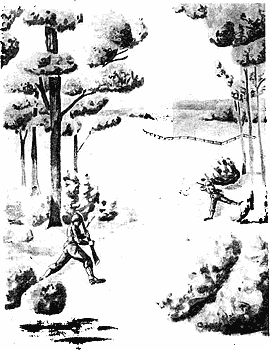
LEAVING WOODS
On reaching the far edge of the woods, the scouts halt under cover, examine the terrain to the front, and wait for the platoon leader's orders or until the signal to advance is given. (See FM 7-10, par. 142d(2).)
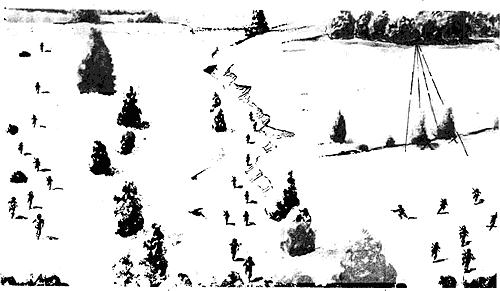
ACTION BY PLATOON WHEN ENEMY IS ENCOUNTERED
When hostile fire is opened on an element of the platoon, the remainder of the platoon continues to advance toward the march objective (taking every advantage of concealment and cover and assuring the necessary security of their flanks). (See FM 7-10. par. 106e.)
ASSISTANCE TO ELEMENT HELD UP
From favorable positions on the hostile flank(s), assistance by fire, or by fire and movement, is given to the element or unit held up. (See FM 7-10, par. 106e.)
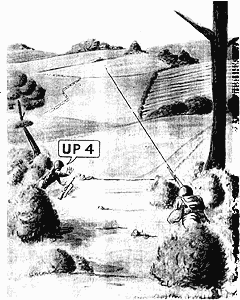
ACTION OF SCOUTS WHEN FIRED ON
When scouts are fired on, they take cover and try to determine the enemy's position. One scout of each pair crawls to the best nearby firing position and opens fire with tracer ammunition to indicate the target, while the other scout observes and orders necessary changes in range. Having adjusted the fire of the first scout, the second scout also opens fire. If the platoon leader is nearby, one scout may open fire while the other points out the target to the platoon leader. (See FM 7-10, par. 142d(3).)
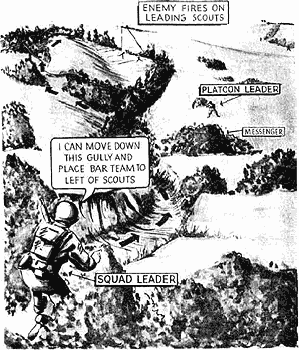
ACTIONS OF PLATOON AND SQUAD LEADERS WHEN THE SCOUTS ARE FIRED ON
When the scouts are halted by fire, the platoon leader makes a quick estimate of the situation and sends a message or otherwise report the location of the enemy and his plan of action to the company commander. Meanwhile, the squad leaders immediately get their squads under cover, study the terrain for covered routes forward, make plans for the employment of their automatic rifle teams, and watch the platoon leader for orders. (See FM 7-10, par. 142e as changed by Changes No. 1.)
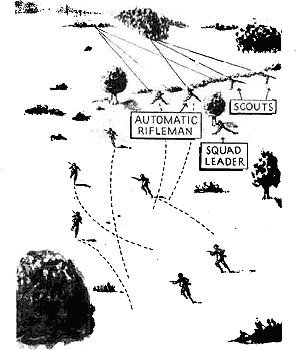
REFORM ON LINE OF SCOUTS
The squad leader may be directed to reform his squad on the line of scouts and open the fire fight as shown above, or he may be ordered to move his squad to a firing position on the hostile flank (ass illustrated on page 50) from which he can more effectively engage the enemy. (See FM 7-10, pars. 106e and 142e as changed in Changes No. 1)
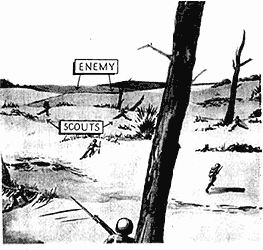
INFILTRATION OF INDIVIDUALS OR GROUPS OF INDIVIDUALS TO FIRING LINE
When there is little cover or concealment and the area between the squad and the firing position is under enemy observation or fire, the squad leader advances his squad to the firing position by sending forward individuals or groups of two or three men at a time. (See FM 7-10, par. 142e(1).)
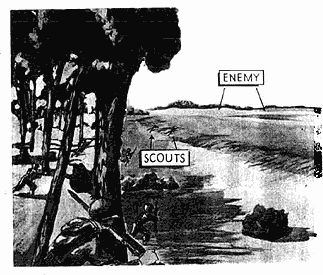
RUSHES
When the enemy fire permits, and the distance to be covered to the firing position is short, the squad is moved forward by rushes. Otherwise, it is preferable to crawl or creep. (See FM 7-10, par. 142e(2).)
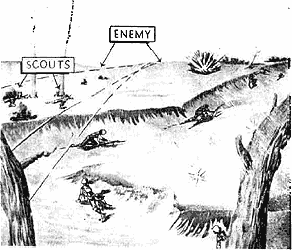
USING COVERED ROUTE OF APPROACH
The squad advances as a unit when there is a covered route to the position. The squad moves forward usually in either a squad column or a diamond formation. The squad leader then issues the fire order under cover and has the men creep or crawl to their firing positions, and open a surprise volume of accurate fire. (See FM 7-10, par. 142e (3).)
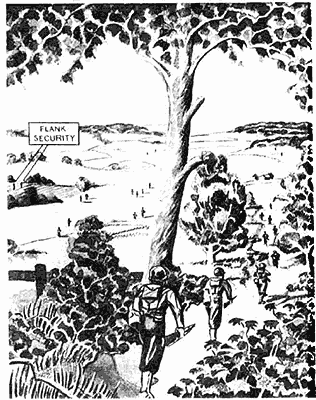
FLANK SECURITY
Every unit is responsible for its own security. Measures for flank protection must be adjusted to fit the changes in the situation as these changes occur. On broken terrain, or when visibility is poor, a small connecting group of two or three men may be employed to maintain contact with an adjacent unit. (See FM 7-10, par. 108b (4).)
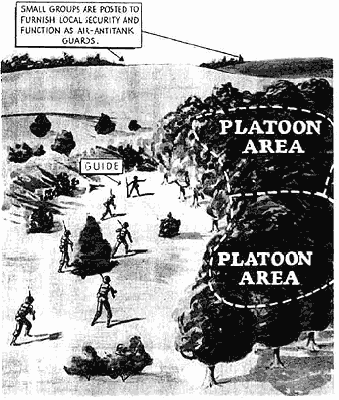
ASSEMBLY AREA
The platoon may attack directly from the approach march (see FM 7-10, par. 106i). Since in such an attack there will be little opportunity for reconnaissance and coordination of plans, such action is ordered only when required by the situation. Otherwise, the platoon is ordered to occupy a designated portion of the company assembly area. The platoon is directed immediately to its assigned section of the area by the company commander or a company guide, or is conducted thereto by a previously designated platoon guide. (See FM 7-10, pars. 14b (1) and 143(1).)
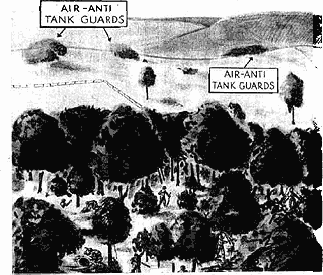
UNITS ARE DISPERSED IN THE ASSEMBLY AREA
The squads, dispersed within the platoon area, take advantage of available cover and concealment and dig in for protection. The assembly area should afford protection from air and ground observation and defilade from the fire of flat-trajectory weapons. Unless it is an intermediate assembly area, it is located usually behind the last cover or mask which can be reached without fighting. (See FM 7-10, pars. 106i, 143a(1).)
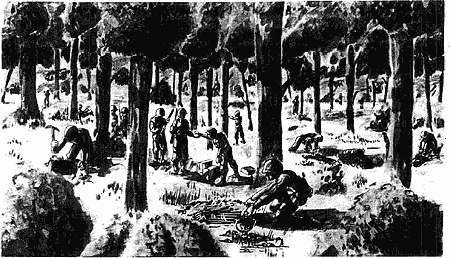
In the assembly area, extra ammunition is issued, equipment checked, and the men rested. If rolls have been carried, they are left here. Leaders reconnoiter the terrain over which the unit will advance, as the time and situation permit, and plan for the attack. (See FM 7-10, pars. 106i, 143a(1).)

INTERIOR GUARD
An interior guard is posted within the platoon area to see that the men do not congregate, or expose themselves or their equipment to aerial or ground observation. (See FM 7-10, par. 143a(2).)
"We have trouble with men bunching up in order to talk to each other. They seem to do this even though it means death"... Combatant on Guadalcanal
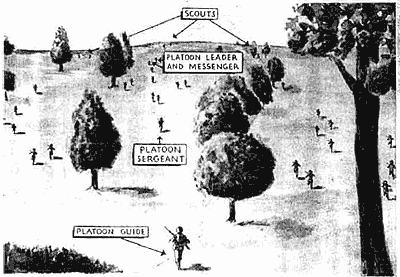
MOVEMENT FROM AN ASSEMBLY AREA
The platoon continues the approach march from the assembly area, changing its formation to suite the terrain and situation. The approach march ends when the fire fight begins. (See FM 7-10, pars. 106h, 144a.)
